The AMD Threadripper 2 CPU Review: The 24-Core 2970WX and 12-Core 2920X Tested
by Ian Cutress on October 29, 2018 9:00 AM ESTHEDT Performance: Web and Legacy Tests
While more the focus of low-end and small form factor systems, web-based benchmarks are notoriously difficult to standardize. Modern web browsers are frequently updated, with no recourse to disable those updates, and as such there is difficulty in keeping a common platform. The fast paced nature of browser development means that version numbers (and performance) can change from week to week. Despite this, web tests are often a good measure of user experience: a lot of what most office work is today revolves around web applications, particularly email and office apps, but also interfaces and development environments. Our web tests include some of the industry standard tests, as well as a few popular but older tests.
We have also included our legacy benchmarks in this section, representing a stack of older code for popular benchmarks.
All of our benchmark results can also be found in our benchmark engine, Bench.
WebXPRT 3: Modern Real-World Web Tasks, including AI
The company behind the XPRT test suites, Principled Technologies, has recently released the latest web-test, and rather than attach a year to the name have just called it ‘3’. This latest test (as we started the suite) has built upon and developed the ethos of previous tests: user interaction, office compute, graph generation, list sorting, HTML5, image manipulation, and even goes as far as some AI testing.
For our benchmark, we run the standard test which goes through the benchmark list seven times and provides a final result. We run this standard test four times, and take an average.
Users can access the WebXPRT test at http://principledtechnologies.com/benchmarkxprt/webxprt/

WebXPRT 2015: HTML5 and Javascript Web UX Testing
The older version of WebXPRT is the 2015 edition, which focuses on a slightly different set of web technologies and frameworks that are in use today. This is still a relevant test, especially for users interacting with not-the-latest web applications in the market, of which there are a lot. Web framework development is often very quick but with high turnover, meaning that frameworks are quickly developed, built-upon, used, and then developers move on to the next, and adjusting an application to a new framework is a difficult arduous task, especially with rapid development cycles. This leaves a lot of applications as ‘fixed-in-time’, and relevant to user experience for many years.
Similar to WebXPRT3, the main benchmark is a sectional run repeated seven times, with a final score. We repeat the whole thing four times, and average those final scores.

Speedometer 2: JavaScript Frameworks
Our newest web test is Speedometer 2, which is a accrued test over a series of javascript frameworks to do three simple things: built a list, enable each item in the list, and remove the list. All the frameworks implement the same visual cues, but obviously apply them from different coding angles.
Our test goes through the list of frameworks, and produces a final score indicative of ‘rpm’, one of the benchmarks internal metrics. We report this final score.
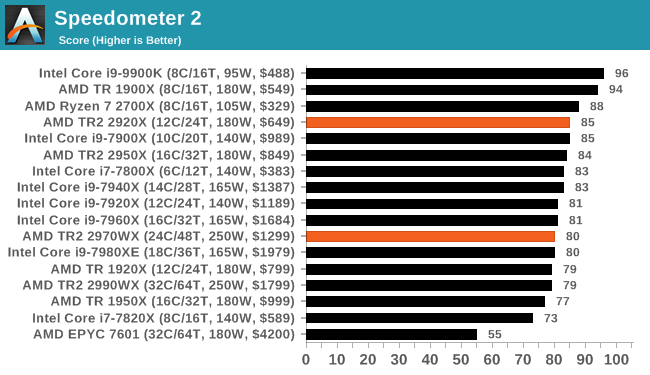
Google Octane 2.0: Core Web Compute
A popular web test for several years, but now no longer being updated, is Octane, developed by Google. Version 2.0 of the test performs the best part of two-dozen compute related tasks, such as regular expressions, cryptography, ray tracing, emulation, and Navier-Stokes physics calculations.
The test gives each sub-test a score and produces a geometric mean of the set as a final result. We run the full benchmark four times, and average the final results.
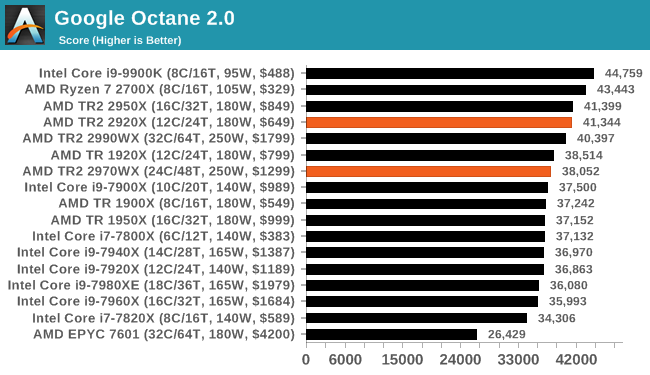
Mozilla Kraken 1.1: Core Web Compute
Even older than Octane is Kraken, this time developed by Mozilla. This is an older test that does similar computational mechanics, such as audio processing or image filtering. Kraken seems to produce a highly variable result depending on the browser version, as it is a test that is keenly optimized for.
The main benchmark runs through each of the sub-tests ten times and produces an average time to completion for each loop, given in milliseconds. We run the full benchmark four times and take an average of the time taken.
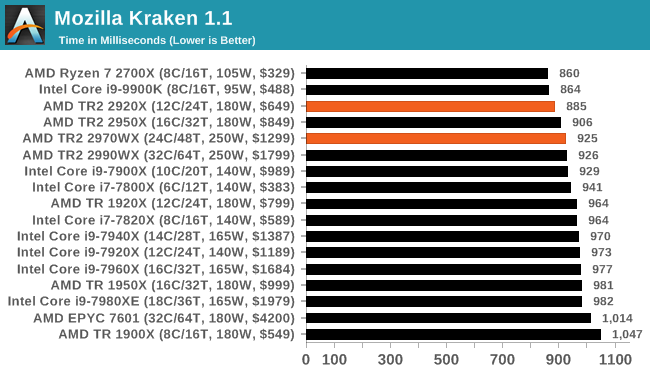
3DPM v1: Naïve Code Variant of 3DPM v2.1
The first legacy test in the suite is the first version of our 3DPM benchmark. This is the ultimate naïve version of the code, as if it was written by scientist with no knowledge of how computer hardware, compilers, or optimization works (which in fact, it was at the start). This represents a large body of scientific simulation out in the wild, where getting the answer is more important than it being fast (getting a result in 4 days is acceptable if it’s correct, rather than sending someone away for a year to learn to code and getting the result in 5 minutes).
In this version, the only real optimization was in the compiler flags (-O2, -fp:fast), compiling it in release mode, and enabling OpenMP in the main compute loops. The loops were not configured for function size, and one of the key slowdowns is false sharing in the cache. It also has long dependency chains based on the random number generation, which leads to relatively poor performance on specific compute microarchitectures.
3DPM v1 can be downloaded with our 3DPM v2 code here: 3DPMv2.1.rar (13.0 MB)
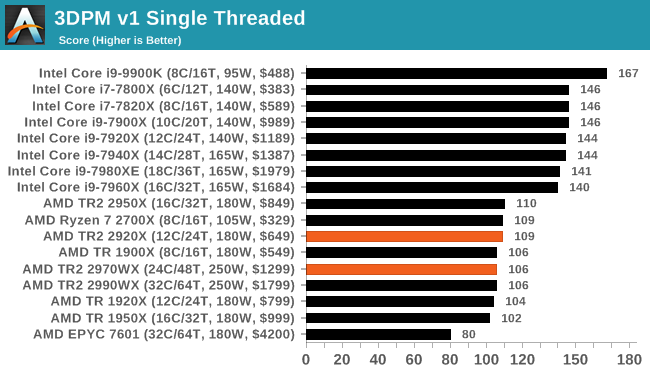
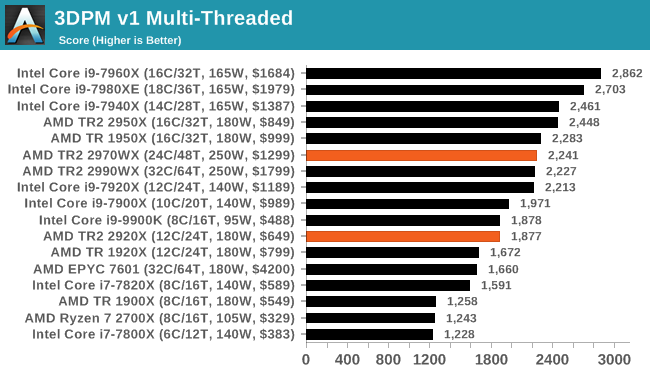
x264 HD 3.0: Older Transcode Test
This transcoding test is super old, and was used by Anand back in the day of Pentium 4 and Athlon II processors. Here a standardized 720p video is transcoded with a two-pass conversion, with the benchmark showing the frames-per-second of each pass. This benchmark is single-threaded, and between some micro-architectures we seem to actually hit an instructions-per-clock wall.
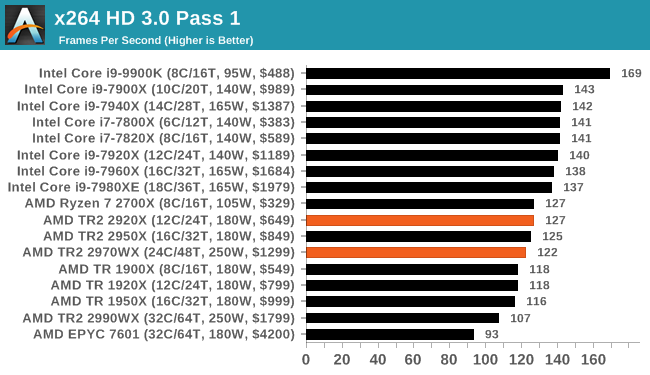
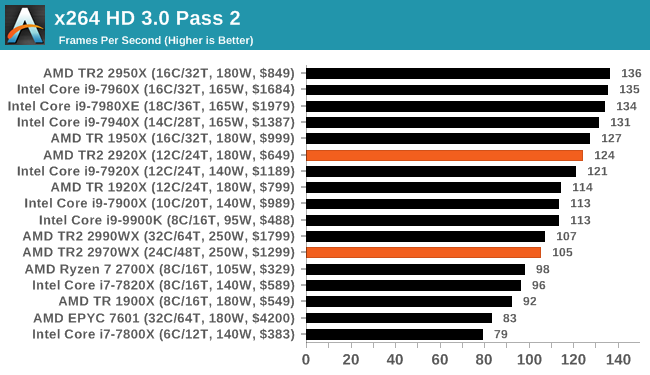










69 Comments
View All Comments
snowranger13 - Monday, October 29, 2018 - link
On the AMD SKUs slide you show Ryzen 7 2700X has 16 PCI-E lanes. It actually has 20 (16 to PCI-E slots + 4 to 1x M.2)Ian Cutress - Monday, October 29, 2018 - link
Only 16 for graphics use. We've had this discussion many times before. Technically the silicon has 32.Nioktefe - Monday, October 29, 2018 - link
Many motherboards can use that 4 additionnal lanes as classic pci-ehttps://www.asrock.com/mb/AMD/B450%20Pro4/index.as...
mapesdhs - Monday, October 29, 2018 - link
Sure, but not for SLI. It's best for clarity's sake to exclude chipset PCIe in the lane count, otherwise we'll have no end of PR spin madness.Ratman6161 - Monday, October 29, 2018 - link
Ummm...there are lots of uses for more PCIe besides SLI ! Remember that while people do play games on these platforms, it would not make any sense to buy one of these for the purpose of playing games. You buy it for work and if it happens to game OK then great.TheinsanegamerN - Tuesday, October 30, 2018 - link
Is it guaranteed to be wired up to a physical slot?No?
then it is optional, and advertising it as being guaranteed available for expansion would be false advertising.
TechnicallyLogic - Thursday, February 28, 2019 - link
By that logic, Intel CPUs have no PCIE slots, as there are LGA 1151 Mini STX motherboards with no x16 slot at all. I think a good compromise would be to list the CPU as having 16+4 PCIE slots.Yorgos - Friday, November 2, 2018 - link
for clarity's sake they should report the 9900k at 250Watt TDP.selective clarity is purch media's approach, though.
2700x has 20 pcie lanes, period. if some motherboard manufacturers use it for nvme or as an extra x4 pcie slot, it's not up to debate for a "journalist" to include it or exclude it, it's fucking there.
unless the money are good ofc... everyone has their price.
TheGiantRat - Monday, October 29, 2018 - link
Technically the silicon of each die has total of 128 PCI-E lanes. Each die on Ryzen Threadripper and Epyc has 64 lanes for external buses and 64 lanes for IF. Therefore, the total is 128 lanes. They just have it limited to 20 lanes for consumer grade CPUs.atragorn - Monday, October 29, 2018 - link
Why are the epyc scores so low across the board? I dont expect it to game well but it was at the bottom or close to it for everything it seemed